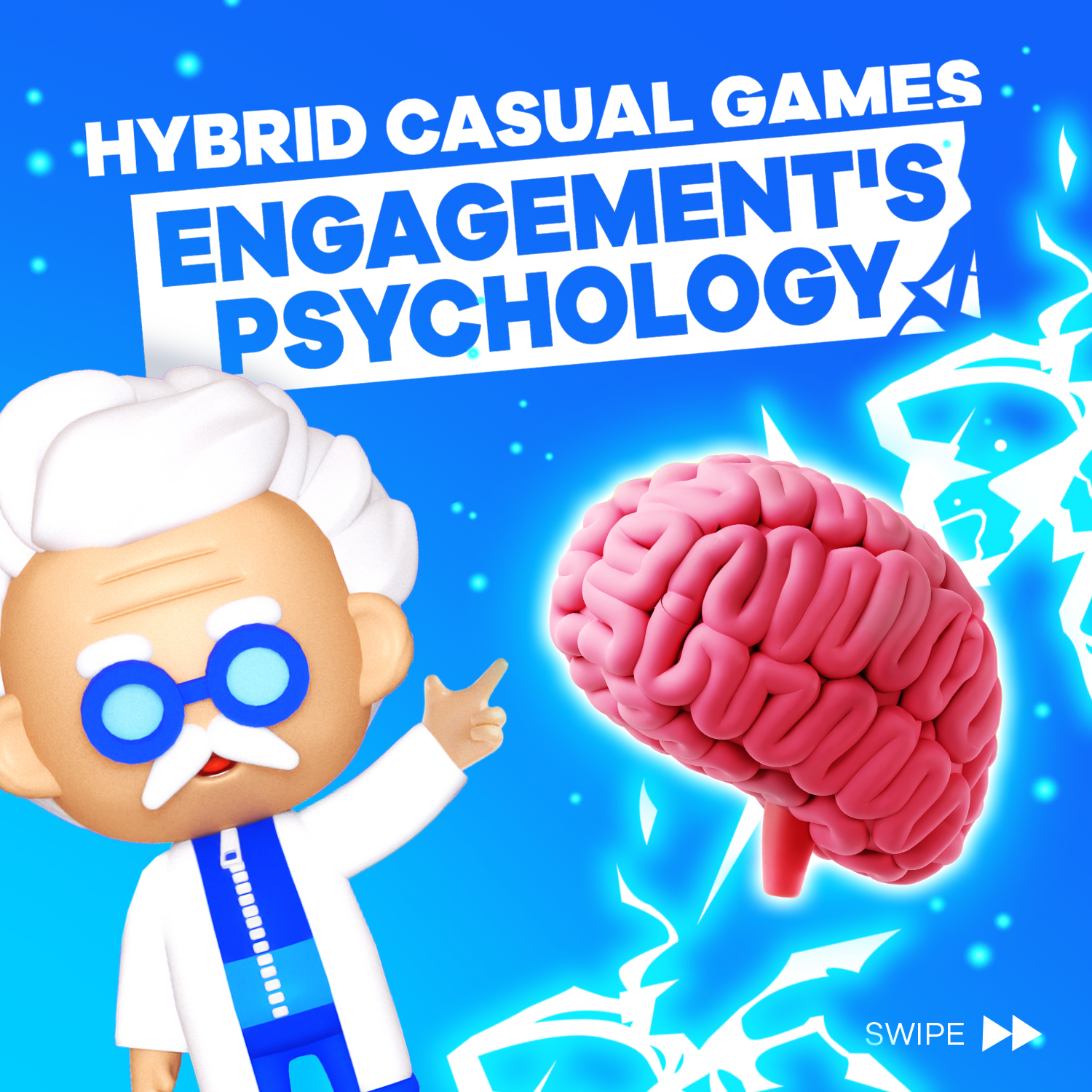
Sarthak Joshi – Dec 11, 2023
Introduction
The gaming landscape has witnessed a dramatic transformation in recent years, with the emergence of a new genre known as hybrid casual games. These games blend elements from various gaming categories to create a distinctive and appealing gaming experience. Notably, publishers once specialised in hypercasual games are now exploring the hybrid realm, reflecting dynamic shifts in the industry. While hypercasual games enjoyed success, the current trend sees a shift toward hybrid games, without implying an impending failure for hypercasual. What makes hybrid casual games so captivating, and why do players find them addictive? In this article, we will explore the captivating world of hybrid casual games, delving into the psychology of player engagement and examining the multitude of factors that contribute to their widespread appeal.
1. Immediate Gratification and Positive Reinforcement
One of the key psychological aspects that engage players in hybrid casual games is the immediate gratification they offer. These games often feature simple mechanics and rapid progression, which means players can experience frequent, small victories. This taps into the principle of positive reinforcement, where players are rewarded for their efforts. As players complete levels, collect rewards, and overcome challenges, they feel a surge of satisfaction and a strong desire to continue playing. The pleasure of achievement becomes a driving force behind player engagement.


(Dreamdale – Fairy Adventure)
Additionally, the immediate gratification principle is a cornerstone in creating an inclusive gaming environment, catering to both casual players seeking quick enjoyment and those looking for more extended gaming sessions.
2. Cognitive Engagement and Skill Development
While hybrid casual games may appear deceptively simple on the surface, they demand players to employ cognitive skills such as problem-solving, strategic thinking, and spatial awareness. This cognitive engagement is not only mentally stimulating but also highly rewarding, fostering a sense of accomplishment as players overcome increasingly challenging levels. The delicate balance between challenge and skill development remains a critical element, ensuring the game remains accessible to a broad audience while offering depth for more committed players.


(Block Jam 3D)
Furthermore, the cognitive engagement in hybrid casual games contributes to enhancing players’ multitasking abilities and decision-making skills, offering more than just entertainment.
3. Social Interaction and Community Building
Many hybrid casual games go beyond individual gameplay experiences by incorporating social features like multiplayer modes, leaderboards, or in-game chat. These elements tap into the fundamental human need for social interaction and healthy competition. Players aren’t just competing against the game’s challenges; they’re also engaging in friendly competition with their friends or other players globally. The establishment of a vibrant gaming community and the opportunity to connect with others elevate the overall gaming experience and significantly contribute to player engagement.

(Stumble Guys)
Moreover, the collaborative nature of these social features fosters a sense of camaraderie, transforming the gaming experience into a shared journey among players.
4. The Dopamine Rush
Dopamine, a neurotransmitter associated with pleasure and reward, plays a pivotal role in the psychology of engagement in hybrid casual games. These games are meticulously designed to release small, regular doses of dopamine. Whether it’s the satisfying sound of collecting coins, completing a level, or earning in-game rewards, these micro-rewards trigger the release of dopamine, creating a continuous cycle of enjoyment. Players find it difficult to resist this pleasurable experience and are drawn back to the game repeatedly.


(Idle Bank – Money Games)
Furthermore, the dopamine rush not only contributes to player engagement but also showcases the careful consideration of game designers to create a positive and enjoyable gaming experience.
5. Fear of Missing Out (FOMO)
Hybrid casual games often incorporate time-limited events, special challenges, and daily rewards, creating a sense of urgency known as FOMO, or the “Fear of Missing Out.” This psychological mechanism significantly contributes to player retention and engagement, as players are motivated to log in daily to ensure they don’t miss out on valuable rewards or exclusive content.


(Idle Lumber: Business Empire)
Additionally, FOMO creates a dynamic gaming environment, keeping players excited and invested in the ongoing evolution of the game.
6. Curiosity and Exploration
Exploration and discovery elements are frequently integrated into hybrid casual games, encouraging players to delve into new features, uncover hidden content, or embark on quests. The element of curiosity and the promise of revealing something new serve as compelling incentives for players. As they strive to uncover all the game has to offer, they remain deeply engaged in an ever-evolving gaming landscape.


(My little universe)
Moreover, the encouragement of curiosity and exploration fosters a sense of discovery, keeping players intrigued and invested in the evolving narrative of the game.
7. Global Trends and Cultural Adaptation
Examine the global appeal of hybrid casual games and how developers adapt their games to diverse cultural preferences. Discuss successful examples of games that have resonated with players from different regions and explore the cultural elements integrated into these games to enhance engagement on a global scale.


(Burger Please!)
By incorporating these additional sections, we can provide a more comprehensive analysis of the psychology of engagement in hybrid casual games, offering readers a deeper understanding of the factors that contribute to the success and popularity of this evolving genre.
Conclusion
In conclusion, the psychology of engagement in hybrid casual games is a multifaceted interplay of immediate gratification, cognitive challenges, social dynamics, and the neurochemistry of pleasure. As this genre continues to evolve, game developers are likely to push the boundaries further, introducing innovative features that resonate with players on an even deeper level. The success of hybrid casual games lies not only in their ability to entertain but also in their profound understanding of the intricate factors that drive player engagement in the ever-evolving world of gaming.
Whether it’s the thrill of victory, the joy of social connection, or the tantalizing dopamine rush, hybrid casual games have carved a niche by appealing to the diverse psychological facets that make gaming an immersive and enduring experience for players worldwide.


